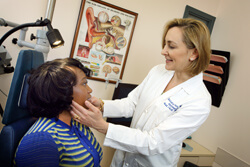
HeadWay
May 1, 2014

While pundits blame greedy doctors, medical errors and health care system fraud, Christine Gourin’s research is highlighting another potential cause: care that doesn’t lead to optimum outcomes.
For example, clinical trial data suggests that treating larynx cancer with chemotherapy and radiation leads to outcomes similar to surgery. But that’s not what Gourin, a head and neck surgeon, and her colleagues were noticing anecdotally in their work. “Increasingly, the surgery we were performing followed nonoperative treatment failure, and often these salvage treatments weren’t successful,” she says.
To gather real numbers, Gourin retrospectively studied Maryland state data and the Nationwide Inpatient Sample. She found that rates of surgery to treat larynx cancer were decreasing, and when surgery was performed, it was more likely to be done in patients who already had nonoperative treatment with radiation. Importantly, those “salvage surgery” patients often had more complications and required more complex reconstruction than those initially treated with surgery, with an increase in health care costs.
Gourin then used the SEER-Medicare Linked Database to explore the impact of these trends on survival. She found that, indeed, patients with advanced cancer were more likely to receive chemoradiation than surgery up front, but patients treated with surgery and postoperative radiation had significantly better survival compared with patients treated with chemoradiation.
It’s unclear exactly why these findings deviate from those of clinical trials, Gourin says. However, she hypothesizes that clinical trials may not capture a realistic patient population, by leaving out the elderly and those with more complicated care scenarios. In addition, the care delivered may differ between the clinical trial setting and the real world.
To determine if differences in care quality were responsible for the discrepancy between her findings and clinical trial results, Gourin and colleagues derived quality indicators based on national treatment guidelines spanning care from diagnosis to the end of life. They found that overall, more than a third of patients received care that deviated from guidelines, and patients who received higher quality care had better survival and lower costs. The exception was for higher quality care for treatment of recurrent disease, which was associated with poorer survival. And yet, after controlling for quality, there was still a survival advantage for surgery with radiation.
These data highlight a pressing need to develop accurate quality measures of cancer care based on real-world outcomes and informed by patient preferences, which has now become the focus of Gourin’s research. By delivering the treatments most likely to lead to the best outcomes, Gourin says, both patients and health care payers can benefit, and a focus on improving quality rather than cost-cutting should be the focus of health care reform efforts.
“Quality health care can be thought of as the right care for the right patient at the right time,” she says. “Because high-quality care is associated with lower costs, these data show that it’s also at the right price.”
For information: 443-997-6467

